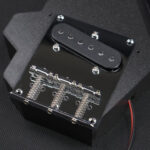Understanding the names of your guitar strings is one of the very first steps in your musical journey. Like learning the alphabet before writing a story, knowing your strings by name and number unlocks a world of chords, melodies, and songs. Whether you’re just picking up a guitar for the first time or looking to solidify your foundational knowledge, this guide will clearly explain everything you need to know about guitar string names and their importance.
What are the Guitar String Names in Standard Tuning?
In standard tuning, the six strings of a guitar, starting from the thickest to thinnest, are named: E, A, D, G, B, and E.
Let’s break that down:
- 6th String: E (Low E) – This is the thickest string, located at the top when you hold the guitar in playing position. It produces the lowest pitch “E” note. Often referred to as the “Low E” string to differentiate it from the thinner “High E” string.
- 5th String: A – The next string down from the Low E string. Tuned to the note “A”.
- 4th String: D – Situated below the A string, this string is tuned to “D”.
- 3rd String: G – Moving further down, the G string is tuned to the note “G”.
- 2nd String: B – This string is tuned to the note “B”.
- 1st String: E (High E) – The thinnest string, at the bottom when holding the guitar. It’s tuned to a higher pitched “E” note, and is called the “High E” string.
It’s important to remember both the names (E, A, D, G, B, E) and the string numbers (6th, 5th, 4th, 3rd, 2nd, 1st). Guitar tabs and instructional materials often use both systems.
Why These Names? Understanding the Musical Notes
These string names aren’t just random letters; they represent specific musical notes in Western music. When you pluck an open string (a string played without pressing down on a fret), you are hearing that string’s fundamental note. Standard tuning (EADGBE) has become the most widely used because it offers a fantastic balance for playing chords and melodies across various musical styles.
The development of this tuning was a gradual process, evolving from earlier stringed instruments and tunings over centuries. Guitar makers and musicians experimented to find a system that was both musically versatile and physically comfortable to play. The EADGBE tuning we use today is the result of that long evolution, proving to be exceptionally practical for playing music.
Mnemonics: Easy Ways to Memorize Guitar String Names
Memorizing EADGBE can seem daunting at first, but there are many fun and effective mnemonic phrases to help you remember the order of guitar string names. Mnemonics are memory aids that use associations to help you recall information.
Here are some popular and creative mnemonics for both ascending (thinnest to thickest) and descending (thickest to thinnest) string orders:
Ascending Order (1st to 6th String – E B G D A E):
- Every Boy Gets Dessert After Eating
- Elephants Buy Green Donuts At Easter
- Eat Big Green Deals And Enjoy
Descending Order (6th to 1st String – E A D G B E):
- Eddie Ate Dynamite, Good Bye Eddie
- Every Average Dude Gets Better Eventually
- Eat All Day, Get Big, Easy
The best mnemonic is one that sticks in your mind. Feel free to get creative and make up your own phrase! The sillier or more personal it is, the easier it will be to remember. Repeat your chosen mnemonic several times a day, and soon you’ll be able to recall the guitar string names effortlessly.
Connecting String Names to the Fretboard
Knowing the string names is just the first step. Understanding how these names relate to the fretboard is crucial for playing guitar. The fretboard is the wooden strip on the guitar neck where you press down the strings to change the pitch. Each fret represents a half-step in musical pitch.
When you play an open string, you are playing its root note (E, A, D, G, B, or E). Pressing down on a fret shortens the vibrating length of the string, making the pitch higher. Learning the notes on the fretboard is a progressive skill, but it starts with knowing your open string names. As you progress, you’ll learn how the notes ascend along each string as you move up the frets. This knowledge, combined with your understanding of string names, will significantly enhance your ability to learn scales, chords, and melodies.
Conclusion: String Names are Your Guitar’s Foundation
Mastering the names of your guitar strings is a fundamental step for any aspiring guitarist. It’s the bedrock upon which you’ll build your musical understanding and playing skills. Take the time to memorize the string names and their order, use mnemonics to help, and start connecting those names to the notes on your fretboard. With this knowledge, you’ll be well on your way to unlocking the full potential of your guitar and enjoying the rewarding journey of learning to play music.
Ready to take your guitar skills further? Explore Fender Play for interactive lessons and songs to help you learn faster and have more fun! Click here for a free Fender Play trial.

